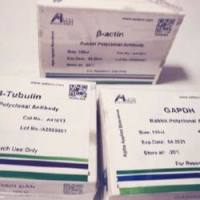Direct Densitometry of Gels
互联网
Materials
- Densitometer 17
- Washed and stained gel from Exercise 4.2
Procedure
-
Using the scanning cuvette supplied with your densitometer/scanner, calibrate the scanner and choose the proper scanning mode and wavelength filter for your application. For example, for the Isco Model 1312, use the instrument on Automatic Scan Mode with a 620 nm filter for Coomasie blue, or a 580 nm filter for silver stained gels.
-
Place the cuvette holder on the lab bench and pour about 10 ml of buffer or acetic acid into the cuvette. Unfixed gels still in the buffer that you used to wash them will work best for this purpose. If the gels have been fixed, be careful of spills and minimize contact with the cuvette to prevent corrosion of the cuvette and long term etching of the glass plates.
-
Place the stained gel into the buffer in the cuvette and orient the gel so that the lanes are vertical as you look at them, with the origin at the top and the front at the bottom. Be careful to gently remove any trapped air bubbles beneath the gel by gently lifting the gel with a blunt glass rod.
-
Very carefully lay the top glass plate onto the gel to hold it flat. The plate should be placed on the gel at an angle, with the two black knobs on the right, and slowly lowered onto the gel. Again, be careful to prevent trapping air bubbles beneath the glass plate.
-
Adjust the scan rate to match that of the recorder (try an initial scan rate of 300 cm/hr). Place the cuvette onto the optical reading device, and manually adjust the position of the gel so that the optical reading head of the scanner is placed just before the origin point of the gel lane to be scanned, in an area where there are no bands. Adjust the baseline of the scanner and recorder to zero.
-
Press and hold the START/STOP button until the scan begins. Continue the scan until the optical head returns to its original position. Be careful that the head does not strike one of the knobs on the top glass plate during operation. This will result in possible damage to the optical unit.
-
When all lanes are scanned, return the gel to storage and carefully clean the gel cuvette.
- Calculate the Rf values for each peak and determine the molecular weights of the proteins located within each peak. Figure 4.9 presents a typical scan of protein standards.
Optional
Modern scanners are equipped with capability to output analog data directly to various computer data management systems, while converting the data to digital information. In addition to storing the scan as a digital reading, these programs can be used to integrate the area under the curves for each peak and thereby yield quantitative data. If such a capability is present on your system, calculate the amount of each protein found within the major peaks.







